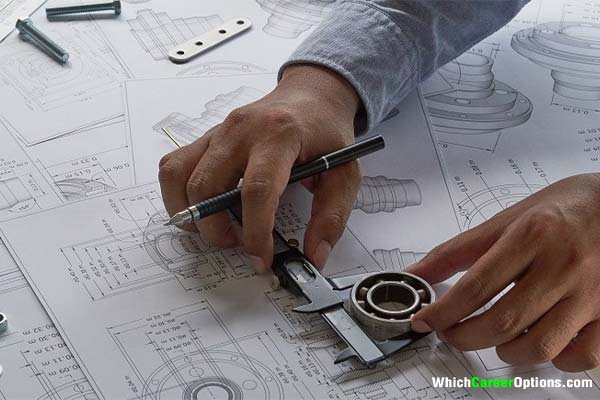What Does a Civil Drafter Do? A Complete Career Guide
Discover what civil drafters do, including key responsibilities, required technical skills, salary expectations, and career growth in engineering design.

Every bridge you cross, road you travel, and building you enter began as precise technical drawings created by civil drafters. If your career quiz results suggest you have strong technical aptitude, spatial reasoning skills, and enjoy transforming engineering concepts into visual plans, this could be your ideal career path in the civil engineering field.
This comprehensive guide will help you understand the civil drafter profession – from daily responsibilities to long-term career prospects in this essential engineering support role.
What is a Civil Drafter?
A civil drafter (also called civil CAD technician) is a skilled professional who creates detailed technical drawings and plans for civil engineering projects. They work under the direction of engineers to convert design concepts into the precise technical documents that guide construction teams.
Key aspects of the civil drafter role:
- Creates 2D and 3D technical drawings using CAD software
- Works on infrastructure projects (roads, utilities, land development)
- Ensures designs meet engineering specifications
- Bridges communication between engineers and construction teams
- Maintains drawing documentation throughout project lifecycles
Key Responsibilities of a Civil Drafter
1. Technical Drawing Production
- Develop site plans, cross-sections, and profile views
- Create detailed construction drawings using AutoCAD/Civil 3D
- Prepare grading plans and earthwork calculations
- Generate utility plans (water, sewer, storm drainage)
- Produce right-of-way and easement documentation
2. Engineering Design Support
- Convert engineer sketches into formal technical drawings
- Calculate dimensions, weights, and material requirements
- Incorporate survey data into base drawings
- Assist with quantity takeoffs and cost estimates
- Update drawings to reflect design changes
3. Quality Control & Compliance
- Verify all drawings meet company standards
- Ensure compliance with municipal regulations
- Check drawings for accuracy and completeness
- Maintain organized drawing files and revision logs
- Coordinate with engineers to resolve design issues
4. Project Coordination
- Prepare drawing sets for permit submissions
- Interface with surveyors and field personnel
- Participate in project coordination meetings
- Manage drawing distribution to contractors
- Create as-built drawings upon project completion
How to Know If Civil Drafting Is Right for You
Your career quiz may suggest this role if you:
✅ Enjoy technical drawing and spatial visualization
✅ Have strong attention to detail and accuracy
✅ Work well with computers and design software
✅ Can interpret engineering concepts
✅ Prefer structured, methodical work
✅ Want to contribute to infrastructure development
If you’re looking for a technical career that combines creativity with precision, civil drafting offers excellent opportunities.
Skills & Qualifications Needed for Civil Drafters
Education & Certifications
- Associate’s degree in drafting technology (preferred)
- Vocational certificate in CAD drafting (alternate pathway)
- Autodesk Certified Professional (valuable credential)
- State-specific certifications (some regions require)
Essential Technical Skills
✔ Proficiency in AutoCAD Civil 3D (industry standard)
✔ Knowledge of MicroStation and other CAD platforms
✔ Understanding of civil engineering principles
✔ Ability to read and create technical drawings
✔ Familiarity with GIS and BIM software
Important Soft Skills
✔ Strong attention to detail
✔ Time management and organization
✔ Communication and teamwork
✔ Problem-solving abilities
✔ Adaptability to new technologies
Typical Career Path for Civil Drafters
| Career Stage | Position | Key Responsibilities |
|---|---|---|
| Entry-Level | Junior Drafter | Basic CAD work under supervision |
| Early Career | Civil Drafter | Full range of drafting tasks |
| Mid-Career | Senior Drafter | Complex projects, quality control |
| Advanced | CAD Manager | Oversees drafting department |
| Specialized | BIM Coordinator | Manages 3D modeling processes |
Salary Range & Job Outlook
- Average Salary (U.S.): $45,000-$70,000 annually (U.S. Bureau of Labor Statistics)
- Average Salary (India): ₹3-6 lakhs per annum
- Job Growth: 5% projected (2022-2032) – Faster than average
- High-Demand Sectors: Transportation, Land Development, Utilities
Key Terms & Definitions
- CAD: Computer-Aided Design software
- BIM: Building Information Modeling
- Topographic Survey: Map of terrain features
- Right-of-Way: Legal land access for infrastructure
- As-Builts: Final drawings reflecting construction
Tips for Starting a Civil Drafting Career
🔹 Master AutoCAD Civil 3D – The industry standard
🔹 Develop 3D modeling skills – BIM is the future
🔹 Build a portfolio – Showcase your best work
🔹 Learn basic engineering principles – Helps create better drawings
🔹 Stay current with codes – Regulations change frequently
FAQs About Civil Drafting Careers
1. What’s the difference between architect and civil drafter?
Architects focus on building design, while civil drafters specialize in infrastructure like roads, utilities, and land development.
2. Is civil drafting a good career?
Yes, with steady demand in construction and infrastructure sectors offering good growth potential.
3. Can I become a drafter without an engineering degree?
Absolutely – many drafters start with drafting certificates or associate degrees.
4. What software is most important to learn?
AutoCAD Civil 3D is essential, while Revit, MicroStation, and GIS skills are valuable additions.
Career Limitations to Consider
⚠ Sedentary computer work with long hours sitting
⚠ Need to meet tight deadlines during project crunches
⚠ Must continuously learn new software as technology evolves
⚠ May require overtime to meet project milestones
Final Thoughts
A career as a civil drafter offers the perfect blend of technical challenge and creative satisfaction for detail-oriented individuals. If your career quiz highlights your spatial reasoning and precision skills, this could be your ideal path in the engineering field.
With global infrastructure needs growing, skilled civil drafters will remain in steady demand. Ready to start drafting your future? Explore CAD training programs in your area today!
